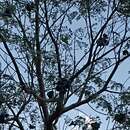fi
nimet breadcrumb-navigoinnissa


Enterolobium schomburgkii is a species of flowering tree in the family Fabaceae.
Enterolobium schomburgkii is also known as "dormidero", because of its minute leaflets reminiscent of Mimosa pudica. Mimosa pudica also called by a similar name ("dormidera").
Enterolobium schomburgkii ranges from Central America to the Amazon basin and even further south.[1]
Enterolobium schomburgkii differs from the similar, sympatric, Enterolobium cyclocarpum by smaller and smoother pods, and by its noticeably smaller, and more numerous leaflets. Unlike other species in the genus, seeds are smaller (<1 cm), its wood is reported to be denser than, for instance, Enterolobium cyclocarpum's.[2] and it is reported to bear fruit only every two to three years[3]
{{cite journal}}: External link in |via={{cite journal}}: External link in |via= Comparison of the fruits of three sympatric species of Enterolobium. E. schomburgkii is the one to the right.
Comparison of the fruits of three sympatric species of Enterolobium. E. schomburgkii is the one to the right. Enterolobium schomburgkii is a species of flowering tree in the family Fabaceae.
A fava-de-rosca (Enterolobium schomburgkii) é uma espécie sul-americanade árvore da família das leguminosas, subfamília das mimosoídea.[1] Tais árvores chegam a medir até 40 metros, de madeira pesada, dura e resistente. Também são conhecidas pelos nomes de timbaúba, timbaúva, timbó-da-mata e timborana.
A fava-de-rosca (Enterolobium schomburgkii) é uma espécie sul-americanade árvore da família das leguminosas, subfamília das mimosoídea. Tais árvores chegam a medir até 40 metros, de madeira pesada, dura e resistente. Também são conhecidas pelos nomes de timbaúba, timbaúva, timbó-da-mata e timborana.
Enterolobium schomburgkii là một loài thực vật có hoa trong họ Đậu. Loài này được (Benth.) Benth. miêu tả khoa học đầu tiên.[1]
Enterolobium schomburgkii là một loài thực vật có hoa trong họ Đậu. Loài này được (Benth.) Benth. miêu tả khoa học đầu tiên.